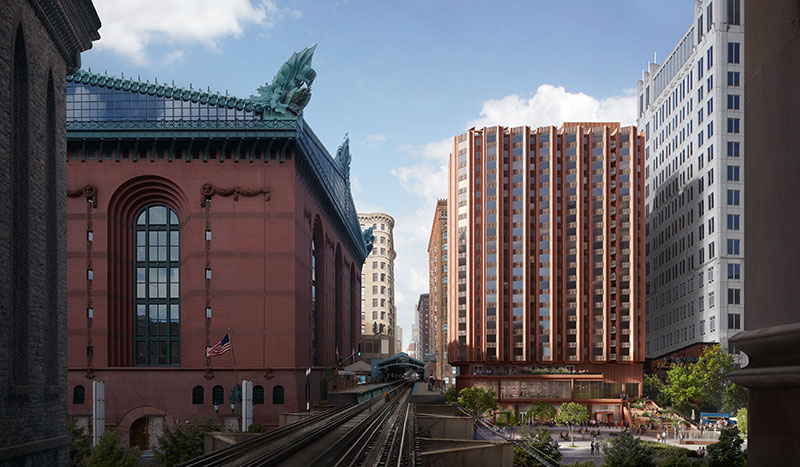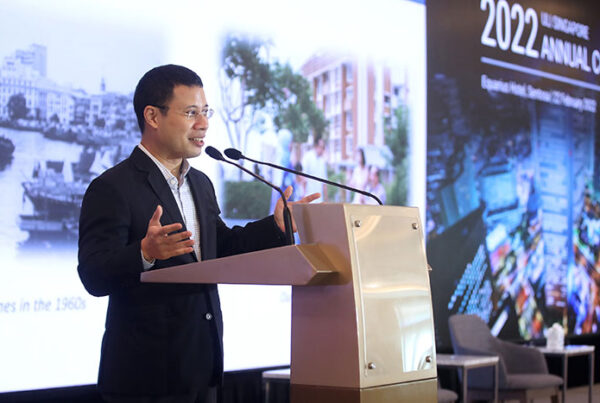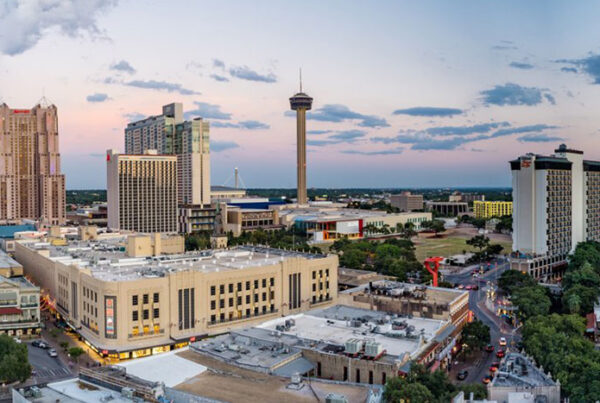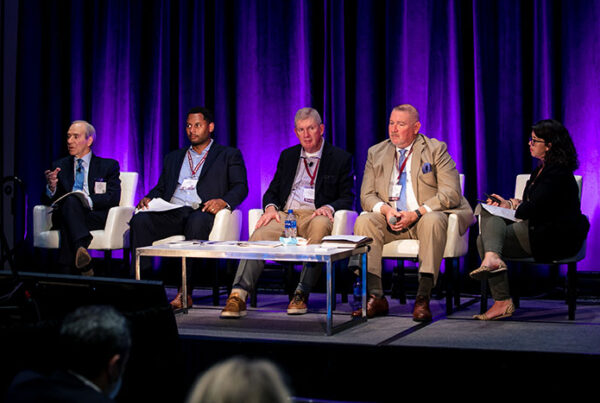
Assemble Chicago, Chicago’s second winner of the C40 Reinventing Cities competition, is a proposed $102 million, net-zero carbon, 20-story apartment building with 207 units. Lead developer is local nonprofit The Community Builders, supported by architecture firm Studio Gang with DesignBridge, structural engineer Thornton Tomasetti, and sustainability experts at dbHMS. (Aesthetica Studio)
![]() Chicago announces its second winner in the C40 Reinventing Cities Competition as developers, owners, and property managers work to meet the city’s goal to power 100 percent of buildings citywide with renewable energy by 2035.
Chicago announces its second winner in the C40 Reinventing Cities Competition as developers, owners, and property managers work to meet the city’s goal to power 100 percent of buildings citywide with renewable energy by 2035.
For much of this past summer, as wildfires raged throughout the western United States and Canada, downtown Chicago’s Loop was enveloped in a murky shroud that was a foul byproduct of the faraway flames. What better time to announce the latest capstone in the city’s quest for the greenest of green high-rise construction, the kind of project meant to help head off the global warming that is the root cause of weather that has veered out of control around North America?
In June, Chicago revealed its second winner in the C40 Reinventing Cities Initiative, part of a global competition bringing together leading developers, architects, urban planners, environmentalists, and innovators to inspire a carbon-neutral future meant to reduce greenhouse gas emissions and other climate risks. Within a sea of sustainability-certifying organizations, C40 stands out as perhaps the most exclusive and prestigious organization of all, sponsoring just a handful of urban competitions every couple of years in places like Madrid, Milan, Paris, and Reykjavik. Thus far, Chicago has been the organization’s singular beachhead in the United States.
Chicago’s C40 winner, Assemble Chicago, is a proposed $102 million, net-zero-carbon, 20-story apartment building with 207 units, some priced for tenants earning minimum wage, intended to rise on a public parking lot site the city has owned and mostly ignored for years. The lead developer is local nonprofit The Community Builders, supported by the celebrated architecture firm Studio Gang with DesignBridge, structural engineer Thornton Tomasetti, and sustainability experts at dbHMS, a mechanical, electrical, and plumbing engineer. Some of the losing submissions were so good that it is expected they will eventually get built somewhere else, even without municipal sponsorship.
Chicago Mayor Lori E. Lightfoot in a press release called Assemble Chicago’s building a “stunning transformation” for its niche in the South Loop neighborhood. Laura Jay, C40 regional director for North America and a Chicago resident, says the project “serves as an important example for cities around the world on how equitable housing, improvement of public spaces, and climate change can be addressed jointly.”

(Studio Gang)

(Aesthetica Studio)
Added Angela Tovar, Chicago’s chief sustainability officer, in a release, “The Assemble Chicago project raises the bar for sustainable design in Chicago.” She predicted that many of its design elements would become standard practice in the city in the future.
Assemble Chicago is the second net-zero C40 winner in Chicago, following the Garfield Green project, which was announced two years ago but is still waiting for the start of construction. Garfield Green, to be located on vacant city-owned land west of downtown, is designed as a low-rise, mixed-use development that will encompass 77 rental units along with retail and public open space. The developer is Preservation of Affordable Housing and the architect is Perkins+Will, supported by Terra Engineering.
An ambitious project that is awaiting its final pieces of financing, Garfield Green has won acclaim for several features: it will generate 100 percent of its power on site with an array of rooftop solar panels (making it net-zero energy), will get its modular building panels from a factory just four miles away, and will process all its stormwater on site.
“Garfield Green is a different kind of setting. It’s lower profile,” says Cynthia Roubik, assistant commissioner at Chicago’s Department of Planning and Development. “Assemble Chicago is the first carbon-neutral building proposed in Chicago’s downtown. That’s a unique challenge. We have other net-zero buildings in the city, but this would be the first high-rise of its kind here. We hope it can be a model for more projects yet to come.”
Greenest City
The special relationship with C40 highlights Chicago’s longstanding commitment to sustainability. There is endless argument about which American city has the most energy-efficient office buildings, but in the most recent U.S. National Green Building Adoption Index for Office Buildings, published in 2019 by CBRE, Chicago ranked as the greenest place to work in the country for the third year running, 2017 to 2019. Following it, in order, were San Francisco, Atlanta, Minneapolis/St. Paul, and Los Angeles.
“Chicago’s commitment to environmental prosperity and climate health continues to set the trend for the entire nation,” Lightfoot declared in the press release. Earlier this year she initiated a Building Decarbonization Working Group involving property owners, affordable housing organizations, labor, and other key groups negotiating ways to help Chicago meet its commitment to the Paris Climate Agreement. The current goal is to power 100 percent of buildings citywide with renewable energy by 2035.
Most observers agree that Chicago’s focus on green came well before Lightfoot—with her predecessors Rahm Emanuel and Richard M. Daley, the 2010 winner of the ULI Prize for Visionaries in Urban Development. Arathi Gowda, an associate director of global architecture firm Skidmore Owings & Merrill in Chicago, cites the city’s longstanding partnership with various certification agencies. A program called Retrofit Chicago Commercial Buildings has been ongoing for a decade.
“From a livability index, Chicago is quite green. We have lots of LEED [Leadership in Energy and Environmental Design] projects around the city, owing in large part to a green permitting process that favors such certifications,” Gowda says. “There is a big chapter of sustainable folks in Chicago, and LEED certification has become a grassroots cause. A lot of good things come together here.”
Achieving Affordability, Energy Reduction
They come together from many directions. The Community Builders has a long legacy in promoting affordable housing. When the firm was confronted with the South Loop C40 site, to be transferred to the developer for free, an idea came into view. The city’s downtown has seen a parade of new condominium development in recent years, but virtually all of it has been luxury priced for white-collar professionals working in the nearby Financial District.
“Chicago has the fastest-growing central business district in the nation from a residential perspective, with tens of thousands of units built for high-income residents,” says Will Woodley, regional vice president for real estate development for Community Builders, which was founded in Boston 55 years ago and today has branch offices in New York City, Washington, D.C., and Columbus, Ohio.
“The growth has been great, but we believe some of that growth has to reach other parts of the workforce. We have a huge industry of service workers downtown—people in shops and restaurants and museums—who can’t afford to live near where they work. The kind of affordable housing we’re putting up in the C40 building is the sort of thing that strengthens both neighborhoods and the local economy.”
The city site for the C40 challenge had the advantage of being adjacent to an elevated rail mass transit station that allowed planners to bypass any setaside for parking. The local electric utility is getting more of its power each year from passive sources, contributing to the decision to design all-electric infrastructure, a common direction in net-zero buildings today.
Still, the site was tight, with 13,000-square-foot (1,300 sq m) floor plates on the bottom floors requiring a slim structure with a minimal rooftop. In addition, even bigger buildings crowd in on all sides. The on-site solar opportunities were scant, with rooftop panels meeting perhaps 10 percent of the building’s power needs on the sunniest of days. “And you can’t cover a building like this in solar panels. That won’t work,” observes Kemena Brooks, senior project manager at Community Builders.
Community Builders had some convenient leverage at hand. The organization was the original developer of the Oakwood Shores Apartments in the Bronzeville neighborhood, located on 94 acres (38 ha) four miles (6.4 km) south of the Loop. After 15 years, Oakwood Shores is ready for renovations, and thus a perfect opportunity presented itself to install solar panels on both those buildings and the sprawling parking lot, Woodley says. The energy generated there will be sold to the grid and offset energy use in the C40 high-rise. Civic leaders liked the plan.
This C40 project, which features a hyper-efficient heat pump, has proposed that each apartment have a smart load center—data-enabled circuit breakers that provide occupants regular reports on their energy use. “The information could come to their phone in an app,” says Sachin Anand, a principal and mechanical engineer with dbHMS. “The experience has been that if tenants can see how much they are using for lighting and appliances and heating and air conditioning, they are more likely to conserve. We may give each apartment an energy budget, and if the tenant beats the budget, they get a discount on their rent or perhaps a meal voucher.
“It’s like having breaker boxes in each apartment, and the cost comes to an extra $800 or so over a typical breaker box,” he says. The reporting may go on to track how much water each apartment is using, both hot and cold. “You can use a stick and tell people if they want to take 40-minute showers they will pay extra rent,” Anand says.
The process for measuring water and energy use is getting more affordable as the cost of specialty software comes down, says Anand.
The designers also used technology—advanced computer modeling—to come up with an ideal window-to-wall ratio of about 25 percent, which is low by high-rise glass tower standards, which often call for inefficient window ratios of 80 percent. The trick at Assemble Chicago was to come up with a building with minimal loss of heat and cool air through windows but enough glass to afford occupants daylight and outside views. The designers also modeled the acoustics in designing windows to face away from the adjacent L tracks.
The building employs many design elements to address resilience, as well. For example, rainwater is collected in a tank at the top of the building, providing enough water to flush toilets if there is a power outage. Anand and his co-designers have upsized the heating system by 5 percent beyond the norm to accommodate unusual weather.
Trash chutes have been designed to separate food waste destined for compost piles from waste going to the landfill. “Most buildings have zero percent diversion, but we think that we can divert 70 percent of the waste in the building away from the landfill,” Anand says. “Our key is keeping things simple. Here it’s as simple as encouraging tenants to use the right trash chute.”
Early on in carbon-neutral thinking, two big objections are likely to get raised. One is that any energy savings project would carry inconveniences that would annoy occupants. The other is that conservation would require more expensive methods and materials—in the case of Assemble Chicago, low-carbon concrete that has been treated to require less building material in its mix—which would carry extra upfront costs and require investor patience through any payback period.
But the Assemble Chicago backers argue that their building will be almost as convenient to live in as any traditional high-rise—assuming tenants get used to the chutes and the water reports—while the increasing availability of green construction materials has lowered costs. It is estimated that, at most, the green elements of the C40 winner added less than $5 million to the budgeted cost, or less than 5 percent.
Two other proposals for the C40 site were the Common Good Collaborative, a 21-story, $100 million tower with 305 residential units and a lead sponsor in Lendlease, and ecoVIBE, a $128.5 million structure that would have spread 224 units over 21 stories, led by a team headed by DL3 Realty Advisors and Perkins+Will.

Above and below at right: Lendlease, which submitted a proposal for the C40 competition, is already blazing trails, with its entire U.S. multifamily portfolio verified net zero. That allows the global developer to offset all the day-to-day operational carbon emissions for residents at properties such as The Cooper and The Reed, a two-building luxury high-rise project in Chicago’s South Loop. (Perkins+Will and Pictury)
 Net Zero: In Theory and in Practice
Net Zero: In Theory and in Practice
The C40 competition offered a clear challenge for net zero innovation. However, sustainability leaders are also setting hard targets. Sara Neff, head of sustainability, Americas, at Lendlease, says “We want to be absolute net-zero carbon by 2040. Going forward, we will be doing net-zero carbon projects.”
In Chicago, Lendlease creative design director Linda Kozloski explains, “because Lendlease’s entire U.S. multifamily portfolio has been verified as net-zero carbon, we’re able to offset all of the day-to-day operational carbon emissions for residents at properties such as The Cooper and The Reed.”
The Cooper, completed in 2018, is a 29-story building on the riverfront in the South Loop composed of 452 apartments and townhouses. As construction gets under way on the second phase, The Reed—slated to be a 41-story luxury high-rise next door—Lendlease is prioritizing the use of low-carbon materials, backed by a life cycle assessment and a related risks and opportunities assessment to aid the developer in working transparently and methodically to mitigate the building’s climate impacts.
Future Possible
Meantime, yet another proposal in the C40 competition, Inspiration Exchange, exemplifies what could be possible in the future. The proposed $42 million project featured 81 studio apartments, half reserved for the homeless and the other half targeting singles and couples earning as little as one-third of area median income. The sponsors included Turnstone Development (the chief source of financing), Inspiration Corp., and MKB Architects. The finished building would have housed a meals program and medical clinic as well as become a home to various nonprofits involved in care for the homeless.
An engineer with MKB Architects planned to capture heat generated by Chicago Transit Authority trains in an adjacent tunnel and funnel it via fans through a heat exchanger into the Inspiration air-sourced heat pumps. The developers also would have piped stormwater into the adjacent Pritzker Park, and each living unit was to get dedicated air delivery to ensure that no COVID-like germs were being passed around. Planners would calculate exactly how much carbon energy was expended in getting construction workers to and from the site each day, gaining bonus points in the C40 competition for providing plug loads for electric car and truck parking. Pepper Construction also gained points for its net-zero-carbon work trailer.
For Inspiration Exchange, the quest might well have resulted in six-petal certification from the Living Building Challenge, one of the most advanced ratings offered anywhere. Certifications come down to such detailed matters as calculating whether construction uses electric arc welding powered by clean energy for the building materials.
The developers had arranged for an off-site solar field in the Auburn Gresham neighborhood. The goal of that and the other measures was fully net-zero carbon operations—not only operating the building on a net-zero basis (amounting to net-zero energy), but also passing back to the grid more energy than is taken out, eventually accounting for all the energy that went into construction, known as embodied energy. “That makes for a fully clean grid,” says Todd Zima, a principal with MKB Architects. He believes that buildings qualifying as net zero will eventually eclipse current LEED guidelines.
Losing out in the C40 competition is not likely to be the end of his proposal, says Evan Cauble-Johnson, chief development officer of Inspiration. He is looking for alternative sites, preferably located near elevated train stations. “That reduces the need for parking, which is important,” he says. “The big benefit of C40 is that the land would be donated to us. Somewhere else, we’ll have to figure out how to cover our land costs.”
Even with Assemble Chicago standing to get its site free, Woodley is still hunting for his required $102 million and predicts that tax credits, together with subsidies from the city itself, will all be part of the mix. Construction is to begin in 2023, with completion around the middle of the decade.
Three Drivers of Net Zero
It is likely that Assemble Chicago and the other C40 proposals in Chicago will serve as models for the ambitious net-zero projects contemplated by building owners around the country. One of the biggest collectives of such owners is working under the sponsorship of the ULI Greenprint Center for Building Performance, ongoing for more than a decade. Currently, 45 companies participate in Greenprint, with 17 committed to bringing their building portfolios to net-zero carbon by 2050; a few, like Heitman, have pegged their net-zero goals to 2030.
While contests like C40 are important to sustainability, three essential elements drive net-zero development, says Marta Schantz, senior vice president of Greenprint. The first is pressure from investors. “Institutional investors are beginning to ask very detailed questions about environmental, social, and governance issues,” she says.
The second is the rise in civic ordinances. For instance, New York City has become notorious among developers for its Local Law 97—a tough rule that calls for million-dollar fines for buildings that fail to meet carbon emission limits. Two years ago, Pittsburgh passed an ordinance requiring net-zero-energy construction in the future. Massachusetts has a new law in place this year calling for net-zero emissions by 2050. California lawmakers are considering rules requiring all commercial builders to use solar power and battery storage.
Finally, building tenants have begun to speak up. Blue-chip names like Amazon and Microsoft have gotten green religion. “Big premier class A occupiers are pushing for sustainable buildings,” Schantz says. “They’re finding that the workers they hope to hire are asking about sustainability. It’s a recruitment tool.”

Older buildings: with no budget for the latest technology, Transwestern employed smart management in reducing energy use from $1.55 per square foot ($16.68 per sq m) annually to just 78 cents per square foot ($8.40 per sq m) at 77 West Wacker Drive, a 49-story, 668-foot-tall (204 m) high-rise built three decades ago. (Sean Williams Photography)
More Industry Leaders
Laura Craft, head of global ESG strategy at Heitman, says her company is rushing to install the latest in LED lighting and motion sensors while firing up heating systems at 6 a.m. in office buildings instead of 3 a.m. In one of Heitman’s key investment funds, carbon emissions were reduced by 10 percent last year alone, she reports. “Our corporate tenants are committing to net zero, so it makes business sense for us to commit to this. As a result of net zero, our tenants expect to be paying less in energy costs in the future,” she says.
The Portland, Oregon–based New Buildings Institute, which tracks net-zero projects, found that 725 projects in North America qualify so far—both retrofits of existing buildings and new construction. “The majority of these buildings are below 25,000 square feet [2,300 sq m],” acknowledges Webly Bowles, project manager for the organization. “But over time we expect to see larger and larger projects come into the fold.”
Elena Alschuler, a vice president and head of sustainability in the Americas at LaSalle Investment Management, a unit of Jones Lang LaSalle in Chicago, has seen 30 percent of Fortune 500 companies commit to net zero, up from 6 percent in 2015. But she is impatient for more tangible evidence of progress. Retrofitting old buildings often proceeds cautiously, she says. As for new construction, “super-efficient high-tech systems and super envelopes for buildings do exist,” she says, but more cost-effective, scalable models are needed to bring them to market.
In Chicago, even older buildings are getting greener all the time. A few years ago, energy costs at 77 West Wacker Drive, a 49-story, 668-foot-tall (204 m) high-rise built three decades ago, ran about $1.55 per square foot ($16.68 per sq m) annually, says Myrna Coronado-Brookover, senior vice president and general manager of the building, now managed by Transwestern. The cost today is 78 cents per square foot ($8.40 per sq m).
In summer, she has learned to “sub-cool” the building at night, when electric costs are lowest, which then requires less use of the air conditioning during the day. Lights are turned off and nonessential elevators closed off at certain times of the day. Through careful plotting of temperatures, just two of four chillers—each 740 tons—are running most days. “We can’t afford the latest technology here,” says Coronado-Brookover. “We do the best we can with what we have.”
Even the losers in the Chicago C40 competition came away from the experience with good feelings. Lendlease was a co-developer of the 21-story Common Good Collaborative and does not rule out trying to find a different spot for the building in the future.
“C40 opens opportunities for groups to come together and try new kinds of development,” concludes Kozloski. “The research and work we did on that project we can bring to other buildings in the future. Everyone is being pushed to become more innovative in their work.”
H. LEE MURPHY is a Chicago-based journalist who has written regularly for the Chicago Tribune, Crain’s Chicago Business, and other publications. across the country.



